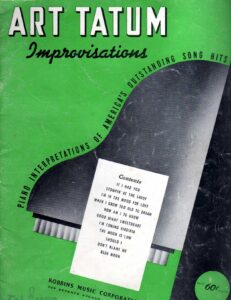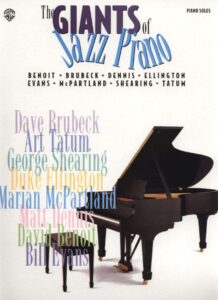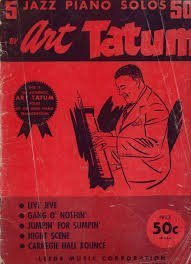Browse in the Library:
Art Tatum – The Art Of Jazz Piano (documentary)

Download the best Jazz transcriptions sheet music.
A few considerations about ART TATUM and his Jazz Piano Music.
He was born into a world in which the piano had become a very important part of the American scene. Pianos were almost everywhere (one piano for every fifteen people in 1920), and they had a dual existence, first as an important tool of recreation and second as a social symbol of their owners’ cultural sophistication. Almost everyone had some kind of experience with it and could appreciate it when it was played well.
There was even a general agreement as to what playing well meant: a whole tradition and set of standards for how a piano should properly be played was established and in place when Tatum arrived. This was a result of more than a century of study of its possibilities, culminating in the achievements of such virtuosi as Chopin and Liszt, to name only the most widely known.
Best Sheet Music download from our Library.

The piano as a physical instrument presents a formidable range of possibilities as to what can be done with it, and in dealing with that challenge a long line of European composers and performers had set a really demanding standard of excellence.
The teaching of piano playing was based on the European tradition, and anyone who took lessons was thereby exposed to the tradition. Most, of course, learned just enough to be able to play simple sheet music and entertain themselves and others at home.
Others felt the excitement of the challenges and the opportunities of the keyboard, and whether they knew it or not set out to follow the paths of the European leaders, trying to achieve excellence on their terms.
Tatum did more than simply follow, of course, but he was one of those who accepted the tradition. He took in more than most of us possibly could from his lessons and his listening, discovering what a difference touch can make, the importance of the pedals, the emotional appeals of different ways of voicing a chord, the heights to which technique can take you.
And further, with what appears to be an absolute minimum of formal instruction, he listened to various kinds of music and grasped the logic of eastern harmony, developed an awareness of the structure of compositions. By all the criteria of the nineteenth-century piano tradition, he made himself into a piano virtuoso worthy to be compared to the best who have ever played.
This achievement certainly did not come from years of hard labor under European-trained teachers, which is the usual route for concert pianists. It seems instead to have come from a very fine match between the opportunities the piano offers, on the one hand, and Tatum’s innate sensitivities and gifts of coordination, on the other.
Once he had been exposed to it and his mind had gotten its teeth into it, he was launched into a search for higher and higher levels of achievement, in the same way the great European artists had been.
He responded sensitively to the nature of the piano, as they had, and he arrived, probably independently, at many of the same ways of dealing with it as they had. His basic gifts, in other words, were world-class, and his gifts drove him to be the pianist he was. Tatum wove the virtuoso tradition and the jazz idiom together in his playing, from the early days of his development, and brought a previously unimagined level of playing into jazz.
The jazz that he started with must have been ragtime, which was still a national craze when he was born. Ragtime started in a fairly simple way but it went through a hot-house kind of development and evolved into a highly technical kind of music in a short time.
By Tatum’s teens the level of difficulty was at least up to Zez Confrey’s “Kitten on the Keys” (1921) and his later “Dizzy Fingers” (1923), which other composers followed up with such titles as “Fine Feathers,” “Feather Fingers,” “Fidgety Fingers,” “Fancy Fingers,” and “Hot Fingers”—all of which were beyond the reach of the casual tinkler.
The whole thing smacks of the popularity of the more and more difficult études that famous pianists turned out in the early 1800s. In listening to ragtime and novelty music, Art Tatum would have been absorbing quite difficult and sophisticated material, built on the basics of the virtuoso tradition even if it was considerably behind its leading edge.
As he developed, he took the complexities of the ragtime music that he heard on player pianos and on early recordings and pushed them to unheard-of heights in his improvising and arranging.
Please, subscribe to our Library. Thank you!
His listening was as good as his playing, and his huge innate talent practically forced him to explore and expand on anything he heard. The particular strain of ragtime that Art Tatum seems to have incorporated and built upon to the greatest degree was Stride Ragtime.

Stride was an eastern version of early jazz piano, developed by players from Baltimore, Philadelphia, and most importantly New York. Contemporary piano players often look down on the stride style as something primitive, but in fact a number of extremely talented if not always tutored men worked the style into something exceptionally complex.
The earliest well-known figures connected with the style, if it’s fair to identify only a few, were Luckey Roberts and Richard McLean (better known at the time as Abba Labba).
There was also One-Leg Willie Joseph, and Jack the Bear, and Paul Seminole, who apparently had a left hand that left others in the dust (and who as a specialty often played piano with his right hand and guitar with his left), and troops of others who had a hand in creating “stride” piano.
But all are agreed that the person who put the stride style together and passed it on was James P. Johnson. He and Willie (The Lion) Smith trained Fats Waller, and it was Fats whom Tatum most publicly claimed as his own model.
James P. was an amazing phenomenon. His influence was enormous, and so must have been his raw talent. He began making piano rolls in 1917 and recordings in 1921.
Before his career was over, he had made 55 piano rolls, cut more than 400 record sides, written some 230 popular songs (including “If I Could Be with You,” “Old Fashioned Love,” and the music that still triggers some odd behavior on the dance floor, “The Charleston”), scored eleven musicals for the stage as well as contributed numbers to more shows that even he could recall, and created nineteen symphonic works. Stride piano, as Tatum would have received it via James P. and other New York pianists, was nothing frivolous, trivial, or primitive.
They were serious in New York, and there was a concentration of disciplined talent and technique there that established a very different standard for performance than was typical in the honky-tonks of the American Midwest and Southwest. It was the virtuoso standard again, although in a very different context from that of the concert hall.
All this was not lost on Art Tatum, even though he was not part of the New York scene as he developed. I think the technical complexity of stride piano must have attracted him; it was certainly the most advanced school of jazz playing that he encountered.
Incidentally, in spite of Tatum’s remark about coming from Waller, I cannot hear any more of Waller than of any other stride pianist in Tatum’s playing, and I think he drew from all the great ones. My guess is that what he found in Waller was a total lifestyle that appealed to him, more than a musical mentor, and that his remark came more from the psychological than from the musical bonding between them.
And as for his not having grown up on the East Coast, all who treasure Tatum should probably be grateful that Art was not born in New York. (The story is that James P. never forgave Joe Turner for even bringing Tatum to New York.)
There’s no way of knowing, of course, but he might never have developed his unique blend of musical trends if he had been swimming in that stream only, doing hand-to-hand combat with the stride giants every night. Instead, he had his own scene in Toledo, and he drew on everything that interested him.
Earl Hines was a pianist outside the stride school who is often mentioned as an influence on Tatum. Tatum never acknowledged the influence, and the argument for this notion has to come from tracing similarities in their styles. Hines, six years older than Art, was active professionally before Art was, so if there was any influence one might argue that it flowed from Hines to Tatum.
One more important thread in the fabric that Tatum wove was Lee Sims, a white pianist entirely outside the realm of jazz.
Moving beyond his own influences, Tatum incorporated all these ways of playing into a style with his own stamp on it. No one ever confuses him with James P. or Fats or Earl Hines or Lee Sims.
He pulled together a variety of approaches to the piano, starting with ragtime and stride but expanding beyond those styles to include elements from both the early and late nineteenth-century classical traditions. Johnson, The Lion, Don Lambert and others tried to do this, too, but their efforts seem weak and piecemeal next to Tatum’s.
Great as they were, Tatum simply transcended them; he had achieved a level of technique equal, many think, to that of the great European pianists who defined the word excellence as it applied to piano playing. The phrase “organic whole” has been used almost to death in recent years, but it still seems the best way to characterize Tatum’s integration of different approaches to piano performance.
In his playing the varying elements became, not so much pieces of a quilt patched together, but threads almost inseparably inter-woven, working as smoothly as the human body itself.
It was his mind, of course, that accomplished this. We’re not talking now about his technical facility or power, which put him in a class with the best pianists of all time. We’re talking about the brain power that controlled his technical gifts, about the strategy with which he deployed his troops, about how he perceived music, remembered music, found relationships, and explored hidden implications of music. These are the things that fed into his improvisation.
Every jazz musician does those things, to a greater or lesser degree. Tatum’s mind did them, not only far faster than anyone else’s, but on different levels at the same time—and then subordinated all the material that his musical intelligence was turning up for him to the requirements
of a particular performance, fitting it to an individual song, or keeping it to a certain length, or even adapting it to a specific piano with its own peculiarities.
Felicity Hewlett once likened him to a hawk going after a fish, adjusting to the wind, judging the waves, and predicting the fish’s turns and dives—an attractive image. Of course, he was the fish, too, and the wind and the waves, setting the problems for the hawk.
As jazz moved beyond ragtime it took as its main subject the popular song. This was a new situation: “the major new problem that faced the creative jazz musician from the late twenties onward [was] that of making good music out of the popular ballad and diatonic, major-minor harmonic system” (Finklestein).
At their best such songs can be superb music, but there are not enough superb songs to go around, and jazz musicians have often applied superior talent to inferior material. The results often were musical triumphs (Louis Armstrong springs quickly to mind here), but they were triumphs that arose “out of a fierce struggle, between the performer and his material, a struggle to give the material a distinction it lacks in the original.”
Musicians tried to develop individual styles that would make their renditions of this common material distinctive.
For the most part, they accepted the published chord patterns for a song and created variations by changing the melody line. Tatum was up to something different. You can see it in Billy Taylor’s description of Art’s sessions with Clarence Profit: “They often jammed together, and one significant feature of their piano exchanges was that they liked to play chorus after chorus of the same melody, each time with a different set of harmonic progressions” (Taylor, Jazz Piano, 20).
One-Leg Willie Joseph, back in the beginnings of the stride tradition, used to do this, too, according to The Lion. Here the standard jazz approach of the time is turned upside down: the melody is accepted as a given, and improvisation is applied to the harmonization. Mait Edey (“Tatum: The Last Years”) has provided the best short description I have seen of what Tatum was up to:
It was his totally different approach to improvisation
. . . which set Tatum apart from the stream of modern
jazz. Unlike most players, his aim was not to construct new
lines over a given [chord] progression, but to play or
suggest the melody of the tune chorus after chorus, erecting
a massive structure of countermelodies, fluid voicings,
substitute chords, and sometimes whole substitute
progressions, beneath it. … At worst, the melody
would be adorned with cascades of runs, at best it would
serve as a mere framework, becoming fragmented into
essential motifs which would constantly recur altered and
revoiced.
The complexity of things going on when Tatum played, and the speed at which they went on, could have been more baffling than dazzling to listeners, but Tatum’s material—basically, the American popular song— was so familiar that it provided listeners with a roadmap, and gave him a free hand to “tantalize the ear with new combinations and challenge the perceptions of his listeners.”
Tatum never lost sight of the melodies of the songs he played no matter how much he varied their surroundings, so listeners seldom felt lost. More often, they just felt played with, as Tatum teased them, led them down paths that seemed familiar, gave them glimpses of pictures on the wall (his little quotations from other music), and then swept them around amazing corners into unfamiliar spaces.
Art Tatum, for all, his immersion in jazz, was playing a kind of concert music, a music designed for serious listening and not for dancing or conversation. He was in a way an alien in jazz, he was something like “news from a distant star.” His playing had more to do with intellect, or with refined craftsmanship, than with roviding a simple accompaniment to fellowship and good times— although he certainly accommodated himself to that in the after hours places he practically lived in. He loved that, too.
He was a remarkable combination of imagination (“a great soaring thing with wings”) and power (“a member of the reptile family”).
He drew on jazz influences, but he had to stretch them, find possibilities that were only implied and then realize them, push forms and devices to their outer limits. He could not do otherwise, and he had to do it within the confines of a career in jazz. Furthermore, he was an early but a towering manifestation of that drive toward complexity and the exploration of new possibilities that has always been inherent in Western music, and that jazz was not about to escape.
If you want to know more about ART TATUM, you can read the book “Art Tatum – Too Marvelous for Words The Life and Genius of Art Tatum ( Book y James Lster)”, available from our Library in June 2022.
